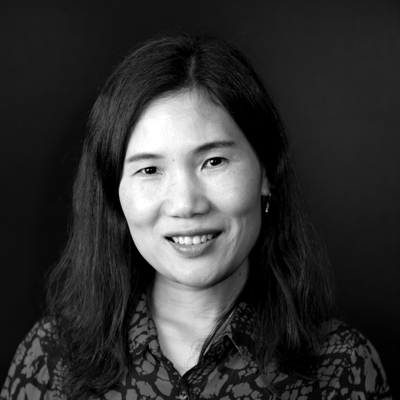Leading the way in clean energy
Professor Xiaojing Hao FTSE is motivated by the desire to create and live in a more efficient and convenient world. She is a curious seeker of the truth.

Professor Xiaojing Hao FTSE is motivated by the desire to create and live in a more efficient and convenient world. She is a curious seeker of the truth.

Professor Xiaojing Hao FTSE is motivated by the desire to create and live in a more efficient and convenient world. She is a curious seeker of the truth. From a very young age, she wanted to be an innovator and a detective – so became a scientist! She is a trained metallurgist, completing her Bachelors and Masters at Northeastern University in China and went on to focus on photovoltaic (PV) engineering during her PhD at UNSW Sydney.
Xiaojing is now a Professor at the UNSW School of Photovoltaic and Renewable Energy Engineering. She is currently also an ARC Future Fellow and leads a research group working on integrating thin film solar cells technologies onto different types of surfaces. Xiaojing has been working on solar cells, harnessing sunlight to create electricity for 16 years. She has recently started exploring ways to use solar cells to make green fuel, like hydrogen and ammonia, from sunlight.
Xiaojing is an expert in her field and has made important contributions to thin film photovoltaic solar cells; particularly in utilising green semiconductor materials to harvest sunlight for electricity generation. She has made vital contributions to the field of PV engineering through her development of efficient, cheap, and environmentally-friendly thin film materials for wide photovoltaic deployment.
She has received over $40 million in funding for her research and has published more than 170 papers in leading journals. She has also received many awards and recognitions for her work, including the NSW Premier’s Prize for Science & Engineering in Energy Innovation in 2018, Australia’s Most Innovative Engineers in 2019 and Prime Minister’s Prizes for Science (Physical Scientist of the year) in 2020.
Xiaojing is also a mum of two kids. She hopes they can grow up in a world where there are no extreme weather events and where energy is clean and affordable.
We recently had the opportunity to hear from Xiaojing. She explains her work and her hopes for the future of applied science, technology, and engineering.

My area of research is solar photovoltaics, I help sunlight to change into electricity using solar panels. We can squeeze more electricity out of sunlight by making the solar cells and panels more efficient.
My vision for future cities is similar to nature. Just like how leaves on trees take their energy from sunlight, our cities can do the same if we introduce this approach to their planning and design. By having as many surfaces around us as possible function like leaves on a tree, solar energy can continue to power our planet.
Science and technology are influencing our future for a healthier, cleaner and safer life for everyone and the generations to come. Given the current urgent global challenges, particularly of climate change, I hope we can realise 100% clean energy in the very near future and that applied science, technology and engineering can accelerate this transition.
In the next 5 years or so, one of my dreams is to see the realisation and wide-deployment of beyond 30% efficiency solar cells made entirely from materials that are stable, abundant, and nontoxic, fulfilling the requirement for wider PV deployment and aiding the transition to 100% clean energy.
Taking on the global challenge of climate change, I hope to bring our PV technology forward to make it more efficient, lower-cost, more flexible, and more widely deployable; providing the net zero, no emission alternatives for our energy needs and improving our life quality.
We remain open-minded to maximise the chance of success for the next generation PV technologies. My group’s recent work on understanding microscopic carrier loss mechanisms, recently published by Nature Energy, has opened the path to further efficiency improvements and re-set expectations for this technology. Another piece of my group’s work on improving perovskite stability has been published by Nature Photonics. With demonstrated stability, this material is among the best seen internationally.
My group’s work on a project that involves the use of a mineral called chalcopyrite has recently attracted $3.08M in funding from ARENA. We will collaborate with our partners to fully utilise this technology as a top cell for chalcogenide/silicon tandem cells, which have proven stability and scalability, making it a likely candidate for commercialisation.
I’m committed to applying my knowledge to advancing next-generation solar photovoltaic technologies, translating them to industry, and developing further engineering solutions to integrated PV products supplying clean electricity for ‘everywhere PV’. I’ll further translate my knowledge of semiconductor device design for efficient solar-fuel production.
As a trained metallurgist, I also hope to use my knowledge to accelerate the transition of traditional energy-intensive industries, such as steel manufacturing, to renewable energy, driving an accelerated technology-led transition to net zero emissions.
And as a dedicated supervisor and mentor, I’ll enthusiastically play my part in the vital task of fostering excellence and diversity in the next generation.
Fifty four years ago Neil Armstrong landed on the Moon. In doing so he made history; overcoming a key challenge of his generation. Our great generational challenge is climate change. I hope I can make a similar giant leap through innovative scientific and technological breakthroughs, inspiring others, and collaborating with multidisciplinary scientists nationally and internationally to achieve our net zero emissions goal.